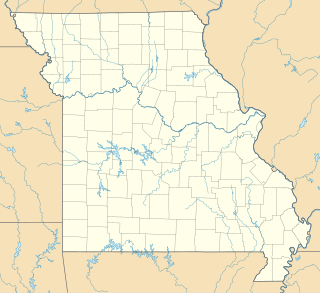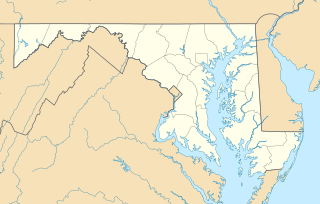
Route 66 State Park is a public recreation area located on the Meramec River at the site of the former town of Times Beach, Missouri. The state park encompasses 419 acres (170 ha) one mile (1.6 km) east of Eureka.

Crowder State Park is a public recreation area of 1,912 acres (774 ha) surrounding 18-acre (7.3 ha) Crowder Lake near Trenton in Grundy County, Missouri, USA. The state park and lake are named after Maj. General Enoch H. Crowder, who was born and raised near the park.

Edward "Ted" and Pat Jones-Confluence Point State Park is a public recreation area located on the north side of the Missouri River at its confluence with the Mississippi River in St. Charles County, Missouri. The state park encompasses 1,121 acres (454 ha) of shoreline and bottomland and is managed by the Missouri Department of Natural Resources, which "plans to restore a natural floodplain reminiscent of what Lewis and Clark might have seen along the lower Missouri River." The park is part of the Mississippi Greenway and sits opposite the Columbia Bottom Conservation Area on the south bank of the Missouri River. Park trails will eventually connect with the statewide Katy Trail.

Ha Ha Tonka State Park is a public recreation area encompassing over 3,700 acres (1,500 ha) on the Niangua arm of the Lake of the Ozarks, about five miles south of Camdenton, Missouri, in the United States. The state park's most notable feature is the ruins of Ha Ha Tonka, an early 20th-century stone mansion that was modeled after European castles of the 16th century.

Hawn State Park is a public recreation area located 14 miles (23 km) southwest of Ste. Genevieve, Missouri. The state park's nearly 5,000 acres (2,000 ha) include three state-designated natural areas: Pickle Creek, LaMotte Sandstone Barrens, and Botkins Pine Woods. Orchid Valley is also considered part of Hawn State Park, but is not connected to the rest of the park and is not open to the public.

Babler State Park is a state-managed public recreation area located in the northwest section of the city of Wildwood, Missouri. A large bronze statue of Dr. Babler greets park visitors. The state park's 2,441 acres (988 ha) offer opportunities for hiking, picnicking, bicycling, horseback riding, and camping. The park was added to the National Register of Historic Places in 1985.

Sam A. Baker State Park is a public recreation area encompassing 5,323 acres (2,154 ha) in the Saint Francois Mountains region of the Missouri Ozarks. The state park offers fishing, canoeing, swimming, camping, and trails for hiking and horseback riding. The visitor and nature center is housed in a historic building that was originally constructed as a stable in 1934.

Cuivre River State Park is a public recreation area covering more than 6,400 acres (2,600 ha) northeast of the city of Troy in the Lincoln Hills region of northeastern Missouri, United States. The state park's rugged landscapes range from native grasslands and savannas to limestone bluffs over looking forested hills. The park offers an extensive system of hiking trails plus swimming and camping facilities and is managed by the Missouri Department of Natural Resources. It encompasses the Lincoln Hills Natural Area and two designated wild areas: Big Sugar Creek and Northwoods.

Missouri Mines State Historic Site occupies Federal Mill No. 3 in Park Hills, Missouri, United States, which processed the lead and zinc ore that was mined in the immediate area for many decades. The site's old power building features a geological and mining history museum and interpretive center focusing on the state's historic Old Lead Belt.

Trail of Tears State Park is a public recreation area covering 3,415 acres (1,382 ha) bordering the Mississippi River in Cape Girardeau County, Missouri. The state park stands as a memorial to those Cherokee Native Americans who died on the Cherokee Trail of Tears. The park's interpretive center features exhibits about the Trail of Tears as well as displays and specimens of local wildlife. An archaeological site in the park was added to the National Register of Historic Places in 1970.

Grand Gulf State Park is a state-operated, privately owned and publicly accessible, geologic preserve near Thayer, Missouri, encompassing a forked canyon that is the remnant of an ancient collapsed dolomite cave system. The land that is now the park was acquired by conservationist Leo Drey (1917–2015) before becoming part of the Missouri state parks system. The 322-acre (130 ha) state park has been operated by the Missouri Department of Natural Resources under a lease agreement with the L-A-D Foundation since 1984. Grand Gulf was declared a National Natural Landmark in 1971 as an excellent example of karst topography and underground stream piracy. A 60-acre (24 ha) portion of the park was designated by the state as the Grand Gulf Natural Area in 1986.

Mastodon State Historic Site is a publicly owned, 431-acre (174 ha) archaeological and paleontological site with recreational features in Imperial, Missouri, maintained by the Missouri Department of Natural Resources, preserving the Kimmswick Bone Bed. Bones of mastodons and other now-extinct animals were first found here in the early 19th century. The area gained fame as one of the most extensive Pleistocene ice age deposits in the country and attracted scientific interest worldwide.

Watkins Mill, in Lawson, Missouri, is a preserved woolen mill dating to the mid-19th century. The mill is protected as Watkins Woolen Mill State Historic Site, which preserve its machinery and business records in addition to the building itself. It was designated a National Historic Landmark and added to the National Register of Historic Places in 1966 in recognition for its remarkable state of preservation. The historic site is the centerpiece of Watkins Mill State Park, which is managed by the Missouri Department of Natural Resources.

St. Mary's River State Park is a public recreation area located in St. Mary's County, Maryland. The state park consists of two sites: one encompasses 250-acre (100 ha) St. Mary's Lake; the second covers 2,200 acres (890 ha) and is largely undeveloped. The park is managed by the Maryland Department of Natural Resources.

Van Meter State Park is a public recreation area on the Missouri River in Saline County, Missouri. The state park consists of 1,105 acres (447 ha) of hills, ravines, fresh water marsh, fens, and bottomland and upland forests in an area known as "the Pinnacles." The park has several archaeological sites, a cultural center, and facilities for camping, hiking, and fishing. It is managed by the Missouri Department of Natural Resources.

Finger Lakes State Park is a public recreation area consisting of 1,128 acres (456 ha) in Boone County near the city of Columbia, Missouri. The state park is unusual in that the site was reclaimed after having been strip mined for coal. It is one of two state parks in Missouri used for off-road vehicles. The history of the other, St. Joe State Park, is also connected with mining.

Graham Cave State Park is a state park in the U.S. state of Missouri consisting of 369 acres (149 ha) located in Montgomery County. The park's namesake, Graham Cave, is a cave in St. Peter sandstone with an entrance 120 feet (37 m) wide and 60 feet (18 m) high and an extent of about 100 feet (30 m) into the hillside. The cave protects an historically important Pre-Columbian archaeological site dating back to as early as 10,000 years ago. Visitors are allowed up to the entrance of the cave where interpretive signs point out significant discoveries. The park includes the 82-acre (33 ha) Graham Cave Glades Natural Area which protects an area of sandstone and dolomite glades with a rich diversity of glade species. The park is adjacent to Interstate 70 from which the entrance to the cave can be glimpsed during foliage-free months.

Rock Bridge Memorial State Park is a geological preserve and public recreation area encompassing 2,273 acres (920 ha), five miles (8.0 km) south of Columbia in Boone County, Missouri. The state park is noted for its excellent examples of karst landforms including the rock bridge, sinkholes, and an underground stream at the cave known as Devil's Icebox. The rock bridge was created by the collapse of a section of a cave which resulted in a small arch of rock being left to form a natural bridge over the creek.

St. Francois State Park is a public recreation area occupying 2,735 acres (1,107 ha) of land five miles (8.0 km) north of Bonne Terre in St. Francois County, Missouri. The state park features a campground, trails for hiking and horseback riding, and fishing on the Big River. The 49-acre (20 ha) Coonville Creek Natural Area, made up of Coonville Creek and its narrow valley, is found within the park's boundaries.

Wallace State Park is a public recreation area located seven miles (11 km) south of Cameron in Clinton County, Missouri. The state park's 502 acres (203 ha) encompass a six-acre (2.4 ha) lake, Lake Allaman, for swimming, fishing, and boating, hiking trails, picnicking facilities, and a campground.



















